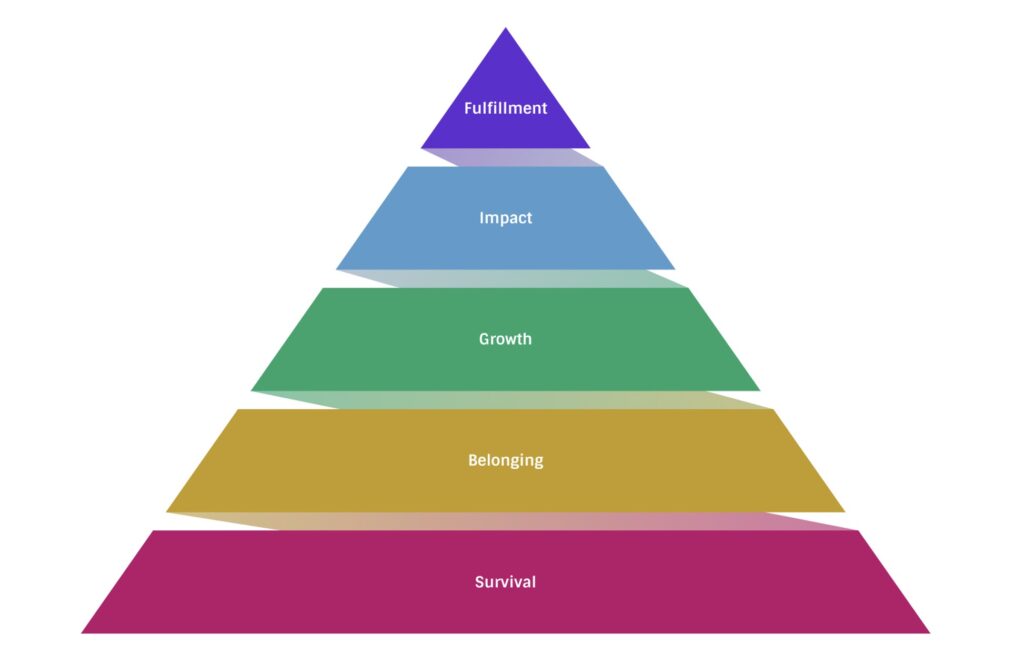There are many ways to understand and motivate a team. You’ve got engagement surveys, well-being assessments, tools like strengths finder, DISC, MBTI and many others that enable a leader to get to know what drives behavior. But they fall short because they don’t uncover each person’s essence: their core values.
Put it this way, I might discover someone’s behavioral style (as per assessments like Deloitte’s Business Chemistry). Great, so Kate, who is our project coordinator, is a Guardian (meaning she’s logical, analytical, risk-averse, and introverted). This is good to know, especially for Cam, our designer, who is a Pioneer (meaning he is creative, visionary, extroverted). In the Business Chemistry framework, these two styles are polar opposites. Kate views Cam as irresponsible and reckless, never finishing what he starts. Cam views Kate as a bottleneck, too focused on compliance and process. By knowing each other’s behavioral styles, they can try to collaborate more effectively. That’s the premise.
But what we don’t know is their values. Imagine if we knew that both Kate and Cam’s primary core value is Family. They share a secondary core value, too: Fitness. Their third core values are quite different — Kate values Safety, and Cam values Freedom.
With this knowledge, leaders and team members suddenly become clearer on what really matters. The leader can unite the individuals based on their love of family and fitness and work to support them in riding the line between freedom/creativity and safety/process.
Of course, behavioral styles are important, but values connect us on a much more profound level. This is why we can have friends who seem so different from us in interests yet with whom we connect deeply.
The benefits of a team understanding each other’s core values
Knowing what each team member values means you can connect with the force that drives their decision-making, minimizing distress and amplifying motivation. Imagine a football team. It’s the semi-finals, and they’re one point down at halftime. If I, as a coach, know that player A values legacy, I can say to him, “Come on, do this to be remembered!” If player B values family, I say, “Do this for your Dad!” If player C values accomplishment, I say, “This is your chance to achieve your dream!”
But you don’t have to be playing sports to use the same approach. In fact, there are many advantages to knowing the values across your team:
- Enhanced Cohesion: Recognizing shared values can strengthen team bonds, fostering a sense of community and mutual respect.
- Increased Motivation: Aligning tasks and goals with individual values can boost motivation, as team members feel their work resonates with their personal drivers.
- Improved Conflict Resolution: Awareness of differing values can facilitate understanding and empathy, leading to more constructive conflict resolution.
- Strategic Decision-Making: Leaders can make more informed decisions by considering the diverse value-driven perspectives within the team, leading to better outcomes.
- Greater Adaptability: A team aware of its varied values can adapt more effectively to change, as it can draw on a broad range of responses and strategies.
Understanding team members’ values isn’t a mere exercise in team building—it’s an essential part of fostering an environment where motivation thrives, and decisions resonate with a deeper sense of purpose.
But why prioritize values? Like strengths and behavioral styles, values act as internal compasses, guiding not just the ‘what’ and ‘how’ of our actions but the all-important ‘why.’ They influence everything from our approach to problem-solving and innovation to our interactions with colleagues and our responses to stress and change. For a leader, knowing what drives each person offers invaluable insights into how to motivate them, how to manage them, and how to help them grow.
Values Diversity Drives Success
Think of the most resilient ecosystems on earth—the ones that weather storms and thrive through change. Their secret? Biodiversity. Similarly, the most resilient and dynamic teams are those with a rich tapestry of values.
- Survival: Those who prioritize safety and security are often the ones who keep the team grounded and prepared for contingencies.
- Belonging: Individuals who cherish relationships are the nurturers, creating bonds that can turn a group of individuals into a tight-knit community.
- Growth: These team members seek knowledge and challenge and are catalysts for innovation and continuous improvement.
- Impact: With their eyes on the horizon, these individuals drive the team towards goals and are often the ones to take the helm in times of change.
- Fulfillment: The visionaries who seek deeper meaning in their work, these members remind the team of the larger purpose and the values that define their collective identity.

Our ancestors understood the power of a community with diverse strengths. A team with a variety of core values is like an ecosystem equipped to thrive in an ever-changing environment. By valuing survival, teams remain vigilant and prepared. By cherishing belonging, they stay unified and resilient. Growth keeps them innovative; impact makes them bold leaders in their field; and fulfillment ensures they never lose sight of their mission.
Navigating Values Bias: The Risk of Homogeneity
Without diversity, certain core values can dominate and skew a team’s perspective. A collective preoccupation with survival can stifle growth, a singular focus on belonging might dampen individual initiative, an overemphasis on growth can create instability, an obsession with impact may invite unnecessary risks, and an unwavering quest for fulfillment could lead to impractical idealism.
Consider the following scenarios:
- A team fixated on survival might miss out on growth opportunities due to risk aversion.
- A group that values belonging above all could struggle with difficult conversations, hindering necessary feedback.
- A growth-centric team may perpetually chase the new, never pausing to consolidate and reflect.
- When impact is the sole focus, the pursuit of prestige and power might overshadow collaborative achievements.
- A team absorbed in fulfillment might prioritize purpose so much that they overlook practical outcomes.
Balancing these values requires a leader’s keen eye and a willingness to embrace each value’s strength while mitigating its excesses. This is why the perfect organizational values will encapsulate values from each category—a belonging value, a growth value, and an impact or fulfillment value. Need proof?
Airbnb’s three values are “Be a Host” (Belonging), “Embrace the Adventure” (Growth), and “Champion the mission” (Fulfillment). LinkedIn emphasizes “Transformation” (Fulfillment), “Integrity” (Impact), and “Collaboration” (Belonging). Dell prioritizes “Direct relationships” (Belonging), “Global citizenship” (Fulfillment), and “Winning” (Impact). Atlassian stands by the values of “Open company, no bullshit” (Impact), “Build with heart and balance” (Growth), and “Play as a team” (Belonging).
We need diverse values to shift from survive to thrive.
The Power of Calm: Shift from Survive to Thrive
Calm within a team doesn’t just enhance well-being—it serves as a strategic pivot from reactive to proactive, from survival to synergistic success. A leader who cultivates calm can help a team weather storms and emerge stronger. Calm transforms a fear-based survival mode into an opportunity for belonging and growth. It creates psychological safety for risk-taking and innovation, allowing those who prioritize impact to lead without leaving others behind. And for the fulfillment seekers, calm paves the way for mindful contribution that complements the team’s objectives.
A story that illustrates this is that of a team facing a critical deadline. The survival-focused members were stressing over the timeline, those valuing belonging were trying to maintain harmony despite the pressure, growth-oriented members were pushing for innovative solutions, those focused on impact were setting bold targets, and the fulfillment-driven were concerned about the project’s meaning. The leader stepped in, creating a space for open dialogue that acknowledged each perspective. By doing so, the team found a harmonious, effective way forward, blending caution with innovation, unity with leadership, and purpose with practicality.
This is effective leadership. In some circumstances the leader will need to reassure the survival-oriented members and encourage those focused on growth. At other times, the leader will need to slow down the impact and growth-seekers in favor of compliance and process.
Business success is truly a game of riding the line between innovation and chaos or process and bureaucracy. It is never-ending, but that is the role of leadership.
Understanding Team Values: The Tool
How does one start to uncover the values driving each team member? That’s where our Team Values Assessment comes into play—a diagnostic tool crafted by Start With Values to provide leaders and teams with a clear picture of their driving values. More than just a survey, the quiz is a catalyst for a richer dialogue about individual and collective motivations.
Participants will discover:
- Their personal values profile.
- The group values profile.
- The unique value each person brings to the table, fostering appreciation and strategic alignment.
- A nuanced understanding of how diverse values contribute to a balanced, effective team.
After discovering the values across a team, a workshop or two with a skilled facilitator will enable you to bridge the gaps, build trust, and highlight how the group can collaborate more effectively.
Values: the Critical Driver
Understanding the core values within your team is not just about enhancing performance; it’s about embarking on a journey toward genuine engagement and fulfillment. It’s a commitment to building a team culture that resonates with authenticity, where diverse values are interwoven to create a robust fabric of collective success.
Leaders who embark on this voyage with their teams discover more than just individual motivations; they unlock the potential for unparalleled synergy. A team aligned in values is a team poised for success—responsive to change, resilient in the face of challenges, and reflective of the best in human potential.
By discovering individual values, you’ll also be better positioned to align the team to your organizational values. You’ll be able to highlight the “values overlap” between personal and organizational values and find ambassadors or change agents within your team who can champion each of the group values. This is how change really happens: you start with values.


